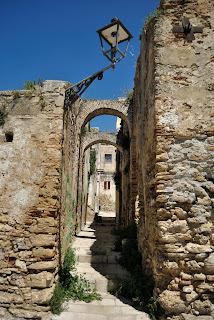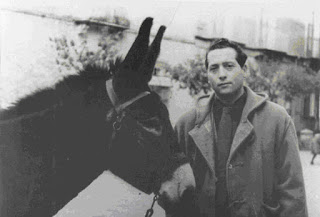 Lucia and I have planned to visit a friend of us, Giovanna, who actually lives in Venosa.
Lucia and I have planned to visit a friend of us, Giovanna, who actually lives in Venosa.Venosa is located in Lucania (nowadays called Basilicata), a wonderful region set beside Apulia.
We leave Altamura early in the morning heading to Venosa, famous for so many things, especially for giving the birth to the Roman poet Horatio; and for its amazing red wine, Aglianico del Vulture.
The day is sunny, as usual over here.
While driving on, I glimpse a village on the top of a hill, like a cherry on a pie.
"That must be Irsina" I exclaimed.
Once a tourist guide told us that the cathedral of Irsina hosts a magnificent statue of Sant'Eufemia, ascribed to the Renaissance artist Mantegna.
So, we can't miss it.
Few miles before arriving at Irsina, we see an old man walking uphill to reach his home.
He must be a peasant. He looks tired, though.
Then,we hear him shouting at us.
I stop my car straight way. "he needs a lift" I wonder.
I'm struck by the vivid color of his blue eyes. He is supposed to be around 80 years old.
I ask "Did you just finish working, right?" "Yes" he replies.
I continue "Do you need a lift to Irsina, correct?" "Yes, sir. to Mondepelòse, please".
Mondepelòse (Montepeluso) is the old name of Irsina.
I enquiry "Sir, do you have a vineyard? You know, I'd like to buy some good wine from those who actually make it".
"Yes, I make Aglianico del Vulture wine" he replies.
"Cool" I say.
Once arrived, we get out of the car.
He goes home. I remain awaiting outside. Few seconds later, an old lady gets out with him.
They lead me to their wine cellar which is into the basement, of course.
I purchase 5 bottles of red wine of Aglianico for a total of 10 euros.
If they had asked me 20 quid, I would have given them 20.
While leaving he shouts at me "Hey, come here!".
He hands me out an extra bottle of wine for free. I love such a man.
It's time to visit the city center of Irsina.

We walk straight to the cathedral.
The city center seems to me magnificent as well as the cathedral.
Unfortunately, this village has experienced a brutal migration to the north of Italy, during the '60ies and '70ies of last century.
Most of Irsinesi have migrated to Sassuolo (Emilia Romagna).
I associate Lucania and her history to people like Rocco Scotellaro, the so called poeta della libertà contadina.
He was mayor of Tricarico.

I'd recommend you to read his two books: "L'uva puttanella" and "Contadini del Sud".
I like to mention that in 2008 I have shot a documentary named Carmine Crocco, dei briganti il generale.
This doc is about the Lucanian movement who fought the Savoia during the so called unification of Italy (1861).
As I had received a prize for that, I dedicated it to the memory of Rocco Scotellaro. I'm proud to say this.
Let's get back to Irsina now.
I just realize that the cathedral is closed. "It gets opened in the afternoon" we are advised.
However, we won't give up our tour around Irsina. So, we keep walking and go further.
We admire an amazing square from which is possible to contemplate the sweet hills surrounding Irsina.
"It seems like Tuscany" I tell Lucia.
I notice a man who stares something far away.
"This is the right person whom to talk to" I think to myself.
"It's beautiful, isn't it?" I address him.

"Yes Sir, it is. That is my land" He proudly points it.
"Few English families have bought a property here. However, living here is not that cheap. C' vonn i sold a mundun (you need a lot of money)" he says.
We keep walking, then, after having bought focaccia and salami, we resume our trip to Venosa.
We get there at around 2 o'clock.
It's time to eat something.
We park beside the archaeological park and the incompiuta, which we are going to visit as soon we eat our meal.
Both Focaccia and salami are delicious.
I sip the wine which I have just bought. It seems good. Even though, I'll realize later that it's pretty alcoholic.
As we are going to catch up with our friend at 4 pm, we have enough time to view both the archaeological site and incompiuta.
The ticket costs just 3 euros, and includes the entry to the castle as well.
The archaeological area dates back to the Roman age.
There is a main road, which divide the area.
On one side there are the thermae, with caldarium, tepidarium and frigidarium.
What about the mosaics? Some of them are very well preserved.
This one portrays Medusa.
it's just fantastic, isn't it?
Moving forward, we enter the incompiuta (XI century), which is basically a Norman church left incomplete; that's why is called incompiuta.
To build it up, it has been used stones taken both from the Roman and Medieval sites.
We do visualize on the walls symbols of unknown meaning like the one below. In case you know what it means, please tell me by leaving a comment below, thanks.
We have completed our tour.
I must say that I'm exhausted.
I still feel the wine affecting my head. I'd like to take a nap, but I can't.
We catch up with Giovanna at 4 pm. She is going to give the birth to a baby.
I ask her to prepare a coffea: I strongly need it.
At 7 pm, we say goodbye to our friend. We still have time to visit the castle, which is right in town.
There is a lot to see.
I wish to mention the permanent exhibition dedicated to the Jew community who actually lived here in the Middle ages.


We get out the castle at 7.30.
The way back is gonna be long.
It was a pleasant trip, though. We have talked with interesting people.
Our tour in Lucania is over, at the moment.
Now it's time to come back home.
Ciao









No comments:
Post a Comment